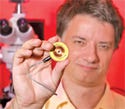November 2, 2007
Originally Published MPMN November 2007
NEED TO KNOW
Lab-on-a-Chip Technology Enables Rapid Blood Analysis
|
Thomas Fischer’s lab-on-a-chip could be used to diagnose a variety of illnesses from a single drop of blood. |
In an age when it seems almost anything can be done in an instant, days can feel like eons when waiting for lab results, especially when a patient’s well-being is at stake. But a lab with a much faster processing time—and a very small footprint—is currently being developed. A professor at Florida State University (FSU; Tallahassee, FL; www.fsu.edu) has designed a portable blood-analysis tool. Thomas Fischer’s lab-on-a-chip is a small device that could be used to quickly diagnose a variety of illnesses from a single drop of blood. Though more research is required to get the diagnostic tool to market, Siemens Medical Solutions USA Inc. (Malvern, PA; www.medical.siemens.com) has already expressed interest in developing the chip technology further.
The device works by exposing the blood sample to low magnetic-field oscillations. This exposure manipulates certain microscopic particles within the sample into moving through an array of magnetic bubbles on the surface of the chip. Medical professionals can then observe where the various particles have aligned themselves. The placement of the particles determines the presence or absence of a disease.
Fischer, a professor of chemistry and biochemistry, worked with FSU postdoctoral associate Pietro Tierno and Tom H. Johansen, a physics professor at the University of Oslo in Norway, to design the portable diagnostic tool. They also collaborated on a paper that appeared in a July issue of the journal Physical Review Letters in which they explain the technology further: “We explored the dynamics of paramagnetic colloidal particles driven through a magnetic bubble lattice by external magnetic-field modulation. The emerging motion may be useful for microfluidic applications like the programmed, directed, or dispersed transport of biological entities attached to the colloidal particles.”
Working with Lars Helseth, an assistant professor at Nanyang Technological University in Singapore, Fischer and Tierno submitted a patent application for the lab-on-a-chip technology that states their goal of controlling the location and movement of molecular objects on a microchip by modulating magnetic domains on the chip surface.
Fischer’s design is intended to be a quick and inexpensive—but, most importantly, accurate—diagnostic tool. However, he anticipates that a few more years of research will be necessary to get the product to market. He notes, however, that “This sort of research is essential if breakthroughs in medicine and the sciences are to occur.”
Copyright ©2007 Medical Product Manufacturing News
You May Also Like



